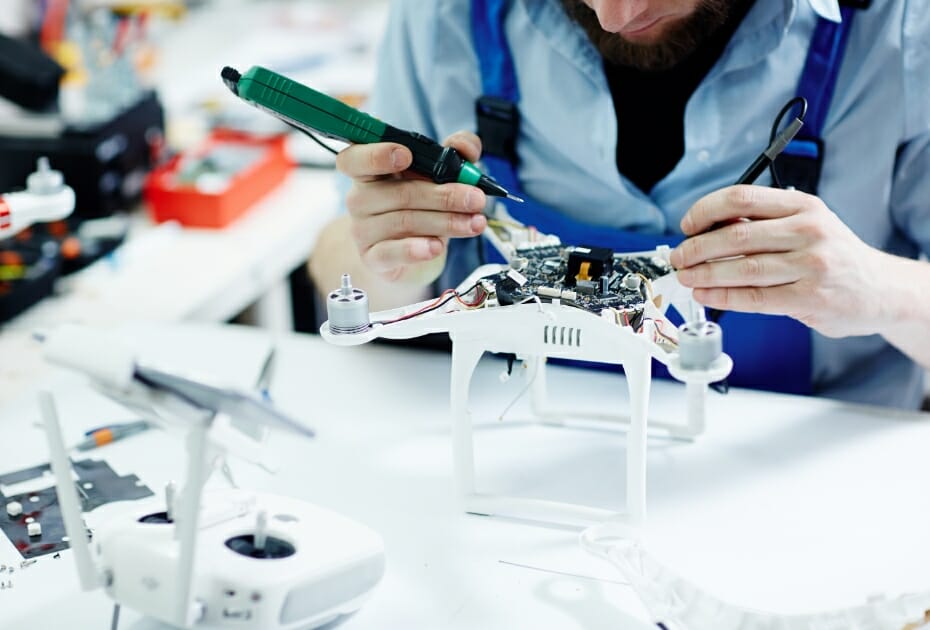

Understanding Crystal Oscillators, Timing Solutions, and Other Components Used in Drone Technology
Formerly known as unmanned aerial vehicles (UAVs), drones are an aerial craft that can be piloted remotely using a controller. They also can be piloted autonomously using software-controlled navigation plans in conjunction with GPS and onboard sensors.
Drones are usually associated with military applications. Some of the most common uses for drones include intelligence gathering, anti-aircraft target practice, and weapons platforms. However, there are plenty of other non-military applications that drones are used for or will be used for in the future. They include:
- Agriculture
- Delivery services
- Photography/videography
- Recreational use
- Search and rescue
- Security surveillance
- Traffic monitoring
- Weather monitoring
How Does a Drone Operate?
The typical drone has two basic functions: navigation and flight mode. All drones require a power source such as fuel or a battery. The drones that run on fuel are mainly the high-end models that are designed for military applications. The majority of drones that you see on the market use a rechargeable battery.
Most drones are made of composite materials to increase their maneuverability and reduce their overall weight. However, this can make them vulnerable to strong winds or objects they may encounter in the skies.
Drones are operated via a controller which allows the user to launch, pilot, and land the drone. In fact, some of the higher-end models have preset commands for landing and certain aerial maneuvers such as flipping. When operating a drone, it’s important to be mindful of the distance between the controller and the drone itself. Because these controllers use radio waves, it’s possible for the drone to go beyond the range of communication and lose signal, which will result in a crash or loss of control.
What Are the Main Components That Make Up a Drone?
The majority of mid-level to high-end drones generally consist of the same parts. These parts include:
- Accelerometer
- Antenna
- Altimeter
- Battery
- Camera
- Electric speed controllers
- Flight controllers
- GPS module
- Receiver
- Sensors (ultrasonic and/or collision avoidance)
The Role of Small Electronic Components in a Drone
We’ve covered all the main pieces of a drone; however, to truly understand how a drone operates, we need to look at the electronic components. Certain electronic components play a specific role in a drone’s capabilities.
For instance, crystal oscillators are responsible for a drone’s wireless communications, micro-processing on both ends, Bluetooth and/or Wi-Fi, timing capture, cameras, sensors, and navigation. Any drone that has autonomous navigation is using a wide array of sensors, which requires accurate timing solutions.
Crystal-controlled clock oscillators (XO) are critical for communications and microprocessor timing. Inductors are used to deliver clean DC power, which is critical for processing data, video, and communications.
Temperature compensated crystal oscillators (TCXO) are used for GPS and radio transmissions to and from the drone. These electric components are especially important when it comes to GPS because the timing and signal need to be accurate to calculate longitude and latitude. Essentially, the better the timing solutions, the better the GPS system is going to work.
Some drones also navigate according to global navigation satellite systems (GNSS), which means they too require accurate timing solutions incorporated into their SDR time board. Specifically, the internal time board uses an oven-controlled crystal oscillator (OCXO) because it delivers a stable and accurate signal, low noise floor, low phase noise, and high frequency stability. GNSS systems have some of the strictest timing requirements, so the OCXO timing solution from ECS Inc. is the ideal solution for those types of drones.
Search ECS Inc. Electronic Components Online
If you are part of a drone project or similar project that demands accurate frequency control solutions for their timing, reliability, and performance, ECS Inc. carries the following timing solutions:
The active and passive components from ECS Inc. are used for medical equipment, computers, consumer electronics, watches, automobiles, and a myriad of other applications. We carry a variety of frequency timing solutions such as quartz crystal oscillators in surface mount, thru hole, and AEC-Q200 styles.
Finding components is easy on the ECS Inc. website. You can either use the Parametric Search function or visit the Search Inventory page. Using our search platform, you’ll be able to locate components by mounting types, resonance frequency, temperature range, size, stability, and other attributes.
For additional information on components or to put in an order, you can either speak with a ECS Inc. sales representative or find a local distributor in your area. Don’t hesitate to reach out to us via our contact form for any additional inquiries.
What Components Are Used in Drones? was last modified: February 14th, 2023 by